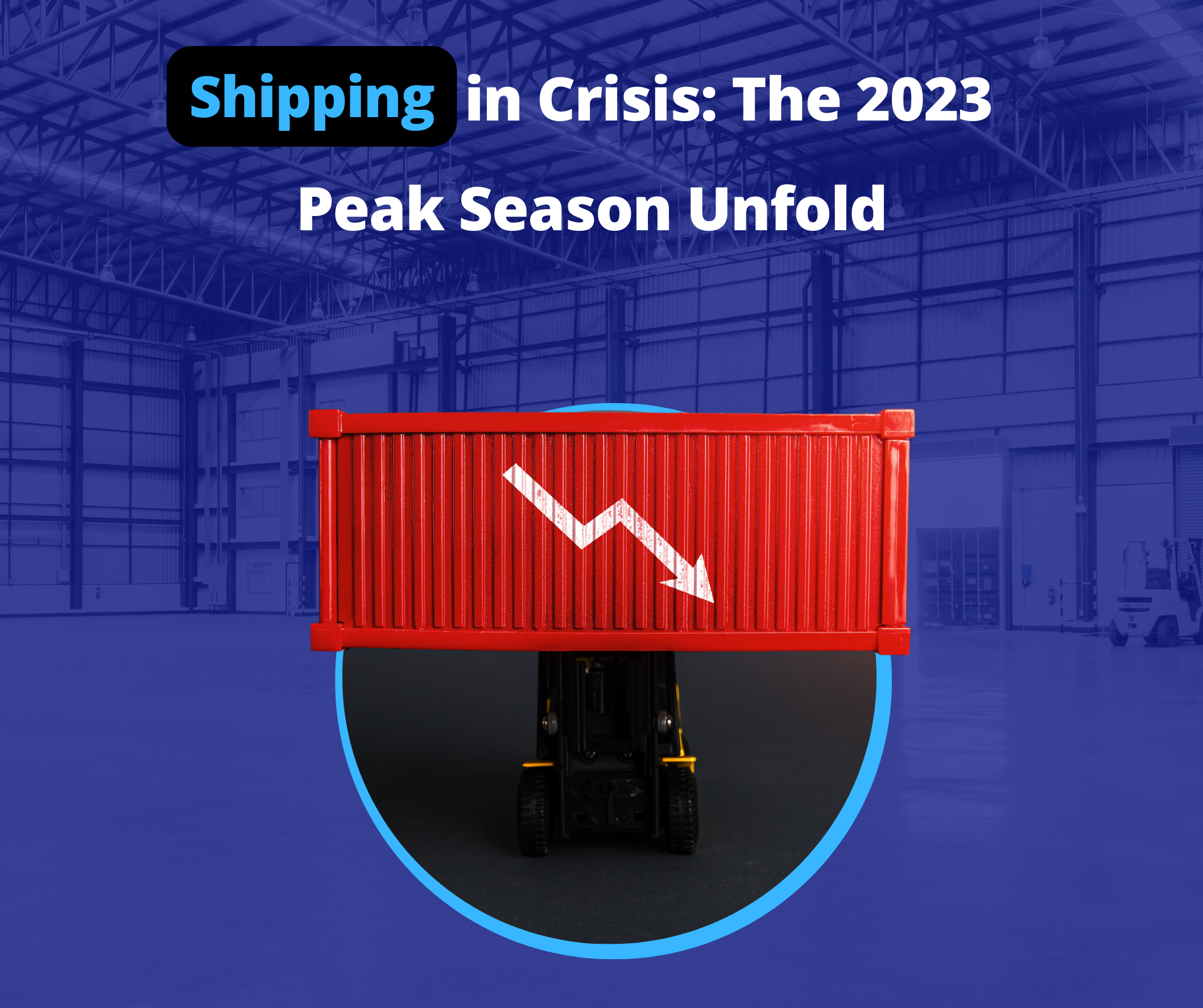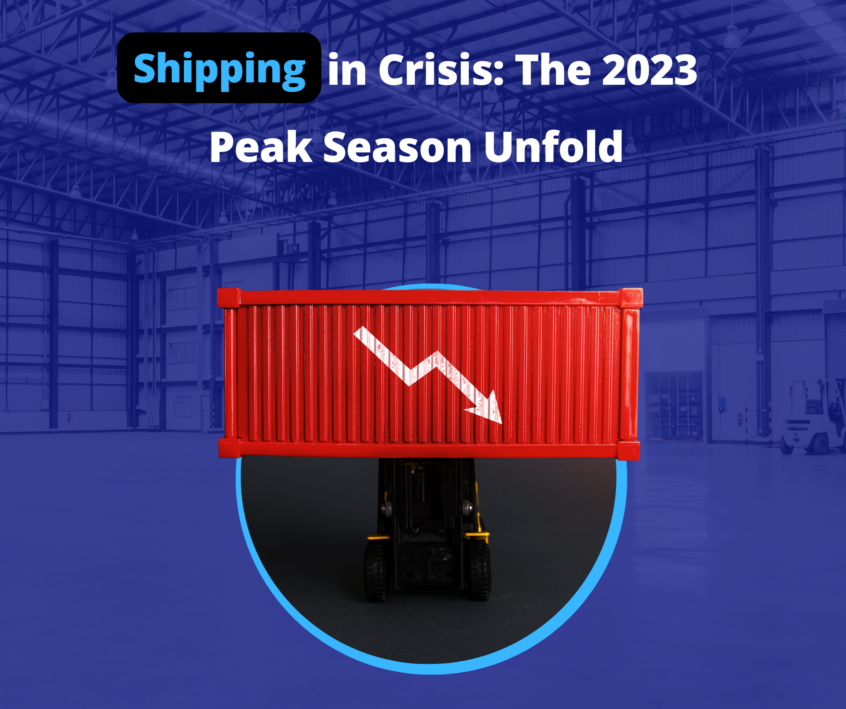
The peak shipping season, traditionally a bustling period for supply chains, is entering with a subdued demeanor this year. As retailers typically hasten to stock consumer markets with clothing, electronics, and holiday decorations, and freight operators gear up to capitalize on surging demand, 2023 paints a different picture. The aftermath of the Covid-19 pandemic has left merchants and consumer goods suppliers grappling with excess inventories.
Logistics companies, meanwhile, are wrestling with tepid volumes and freight rates that fall significantly below the levels seen a year ago. In this article, we delve into the state of this year’s peak shipping season through a comprehensive analysis of charts and statistics. We also explore how these trends are impacting the logistics and shipping industries.
The Anemic Peak Shipping Season
Compared to previous years, this year’s peak shipping season shows limited promise. U.S. ports, which serve as gateways for goods cascading through trucking and rail networks to reach distribution centers and stores, have been trailing behind 2022 levels throughout the year. The National Retail Federation’s forecast of potential import declines in September and October further emphasizes this subdued season.
The key to understanding the trajectory of the peak shipping season lies in inventory levels held by retailers and their expectations for replenishing these stocks. July saw the Logistics Managers Index hit its lowest point in its six-and-a-half-year history, indicating dwindling expectations for shipping demand. Simultaneously, inventories were in contraction, underlining the prevailing caution among retailers.
The Challenge of Destocking
Retail giants like Walmart, Target, and Home Depot have made progress in destocking. Still,they remain cautious about rushing goods to market without clear signals of consumer demand. This cautious approach stems from their efficiency efforts and lean inventory positions. While there has been progress in this regard, inventories remain elevated, particularly for clothing, household appliances, and smartphones.
Jason Miller, interim chair of Michigan State University’s supply-chain management department, affirms that retail inventories continue to hover at higher levels, especially for certain categories of products. This persistent elevation in inventories sets the stage for what appears to be a weak peak season in 2023.
Changing Consumer Spending Habits
Shifting consumer spending patterns have also played a role in shaping this year’s peak shipping season. Americans are channeling their spending toward services and experiences, such as vacations and dining out while scaling back on purchasing various goods. Large retailers like Walmart are witnessing a focus on essentials like groceries, diverting attention from the consumer goods that typically fuel peak-season demand.
The recalibration of consumer spending and the accompanying uncertainty have led retailers like Macy’s and Dick’s Sporting Goods to scale back on orders. Macy’s CEO, Jeff Gennette, noted that consumers maintain healthy savings but exercise caution in their spending choices.
Disappointing Expectations for a Turning Point
Freight executives had high hopes that the 2023 peak season would mark a turning point after a year of lackluster import volumes. However, the reality has been far from their expectations. Inbound trade during the summer months expanded only marginally. This tepid growth has led some ocean carriers to cancel trans-Pacific sailings and revise their expectations for the remainder of 2023.
Vincent Clerc, CEO of A.P. Moller-Maersk, one of the world’s largest container-shipping companies, revealed that retail and lifestyle shipments have experienced double-digit declines compared to previous years. The absence of signs indicating a volume rebound in the latter part of the year has further dented optimism within the industry.Southern California’s Quiet Ports
The focal point of the peak shipping season, which typically revolves around Southern California’s bustling Los Angeles and Long Beach ports, is currently characterized by an unprecedented sluggishness. This development is striking, given that this port complex ranks as the busiest in the nation. Import volumes at these crucial ports took a drastic nosedive, plunging by over 10% between June and July.
These figures represent a stark departure from the usual vigor associated with this period. They are reminiscent of levels observed in December 2022. Of even greater concern for the industry’s future prospects is the notable decline in the export of empty containers from these ports destined for Asia, a decline attributed to the sluggish demand from Asian factories. In July, exports of empty containers from the Port of Los Angeles plummeted by a significant 39% compared to the same month the previous year.
The implications of this unusual lull in the Southern California ports are far-reaching, reverberating through the entire logistics and shipping industry. As these ports typically serve as pivotal gateways for the inflow and outflow of goods, the substantial drop in import volumes underscores the broader challenges the industry faces in 2023. The reduced export of empty containers back to Asia amplifies concerns about the health of the global supply chain and the weakened demand for U.S. exports, which, in turn, impacts the overall vitality of the industry. This unexpected downturn in one of the industry’s primary epicenters underscores the need for adaptability and resilience among industry stakeholders as they navigate the evolving dynamics of the current shipping landscape.
Implications on Trucking & Rail Transport
The notable reduction in container flow entering the country has immediate ramifications for the trucking industry, resulting in a diminished volume of loads available for truckers to transport from ports and rail yards to warehouses and distribution centers. The initial cautious optimism that permeated the trucking sector at the beginning of the year has gradually waned, replaced by a prevailing sense that a full recovery may remain several months away.
While not entirely discounting the possibility of a market inflection in the coming months, industry leaders are predominantly abstaining from making forecasts of such a transformative turning point. Instead, their base case scenario is centered on a more subdued outlook—a modest seasonal upswing expected during the fourth quarter. This shift in sentiment reflects the ongoing uncertainty and challenges the trucking industry faces in the wake of the current shipping landscape.
Thinning Intermodal Circulation
Intermodal rail transport, an integral facet of supply chains renowned for its robustness, faces an unprecedented challenge in 2023 as it grapples with a sharp volume decline. This critical component, which typically thrives in facilitating the movement of containers and truck trailers via railroads, is currently witnessing an alarming thinning of volumes that has yet to be observed in several years. The Intermodal Association of North America underscores this concern by highlighting that business activity in July merely managed to surpass levels recorded earlier in the year, providing no promising indications of an imminent uptick in freight volume.
The situation is further exacerbated by the absence of significant predictions regarding a peak season from customers. Consequently, the prevailing sentiment within the intermodal sector remains cautious and marked by a “wait-and-see” approach, reflecting the evolving economic landscape and the uncertainty that permeates the industry’s outlook.
Wrapping Up
The 2023 peak shipping season has arrived with uncharacteristic restraint, casting doubts on its potential as a catalyst for freight demand. Factors such as elevated inventories, shifts in consumer spending habits, and tepid growth in import volumes have created an environment of caution within the logistics and shipping industries. While hopes were high for a turning point, the current reality suggests that the recovery may still be on the horizon, making it a challenging year for the sector.
As the peak season unfolds, industry players must continue to adapt to these changing dynamics. Monitoring inventory levels, responding to shifting consumer preferences, and maintaining a flexible approach to supply chain management will be crucial. In the meantime, the logistics and shipping industries will remain resilient, poised to navigate the complexities of the 2023 peak shipping season and any future uncertainties that may arise.



